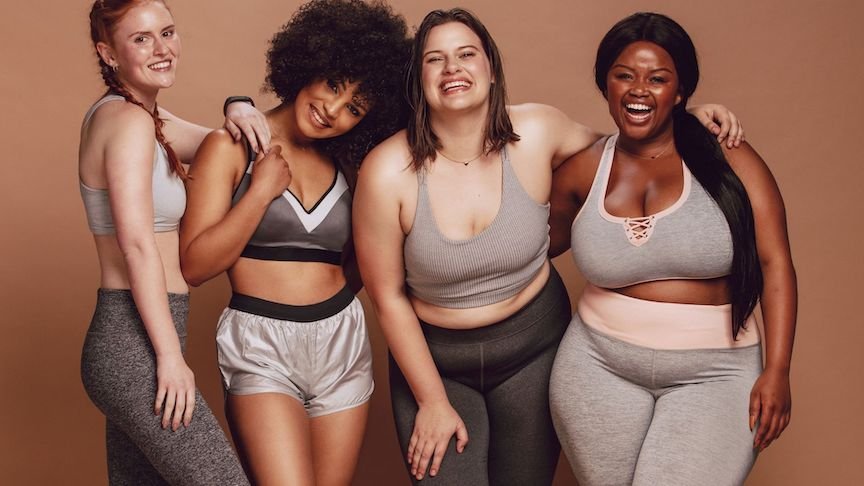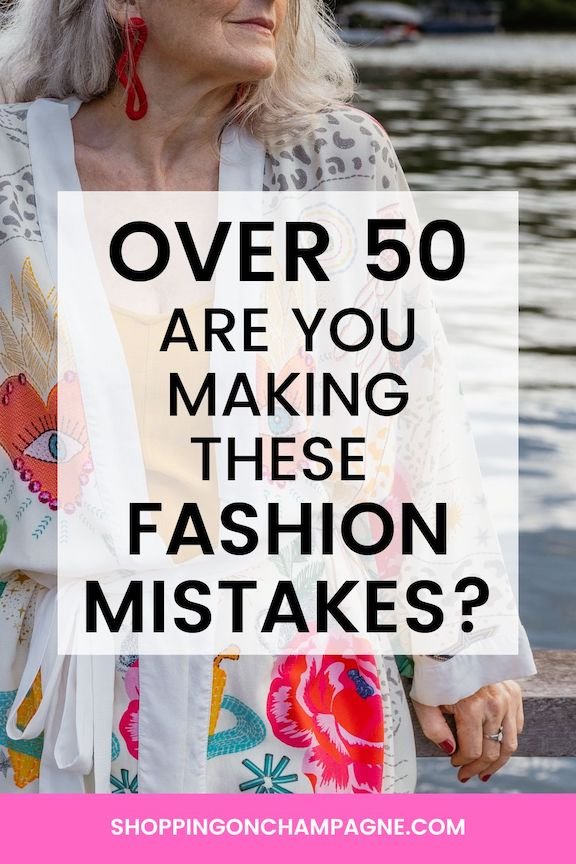Are You Making these Fashion Mistakes?
Now that you’re over 50, do you ever question fashion rules? I've been there too.
Today, I'm unraveling the top style mistakes we should be wary of while celebrating the timeless charm of mature elegance. Together, we'll discover how to balance youthful flair with sophistication, ensuring your wardrobe choices highlight our best features, resonate with current trends, and remain comfortably chic.
Dive in with me, and let's embark on this transformative style journey. Remember, while fashion evolves, confidence remains your most stunning accessory.
Fashion isn't reserved for the young; with age comes wisdom, which includes understanding the significance of personal style. For women over 50, fashion plays a role in boosting confidence and self-esteem. While everyone has their unique style, there are some common mistakes women over 50 tend to make. Here are the top 10 style mistakes to avoid.
#1. Struggling with Age Appropriate Dressing
Age-appropriate dressing can confuse many, as personal style evolves over time and trends shift rapidly. The aim is not to confine oneself to a set of rules but to present oneself in the best possible light, embracing authenticity and adaptability. Here's a deeper dive into the topic:
The Dangers of Dressing Too Young:
Misrepresentation: Dressing too young might send the wrong message about your maturity level or professional status.
Attention: It may draw unwanted attention or make you feel like you're not being taken seriously.
Confidence Issues: Wearing clothes designed for a significantly younger demographic might make you feel out of place or less confident.
The Pitfalls of Dressing Too Old:
Aged Perception: Dressing older than your age might make you appear out-of-touch or overly conservative.
Missing Opportunities: In certain industries, dressing too conservatively can limit opportunities, as it might make you seem less adaptable or innovative.
Physical Impact: Wearing clothes that don't flatter your current physique can age you unnecessarily, making you appear older than you are.
Striking the Right Balance:
Understanding Trends: It's not about blindly following every new fashion trend but understanding which ones can be incorporated into your wardrobe to give it a fresh feel.
Focus on Fit: Well-fitting clothes can do wonders. Invest in tailored pieces or adjust off-the-rack items to fit you perfectly.
Accessorize Thoughtfully: Accessories can bridge youthful exuberance and mature sophistication. A classic watch, a chic scarf, or a tasteful necklace can elevate an outfit.
Classic Yet Modern:
Staples with a Twist: Think of a classic white shirt with an asymmetrical cut or unique button detailing. This fusion retains the essence of a timeless piece while adding a contemporary touch.
Material Matters: Modern fabrics that offer comfort, durability, and style can significantly affect an outfit's overall look and feel.
Color Choices: While having neutrals in the wardrobe is good, don't shy away from colors. However, choose hues that resonate with your personal style and complexion. A pop of color can be youthful, but the shade and how you wear it can add sophistication.
Personal Authenticity:
Age is a Number: At the end of the day, age is just a number. The primary concern should be feeling good about what you wear.
Evolve with Time: Allow your style to evolve with you. As you experience different life phases, your style might shift. Embrace it while retaining the essence of who you are.
Seek Inspiration, Not Imitation: Look to style icons or public figures who resonate with you for inspiration but always put your unique spin on what you wear.
#2. Ignoring Body Shape
Dressing according to one's body shape is a timeless principle in fashion that encourages individuals to highlight their best features and feel more confident in their choices. Let's delve deeper:
Understanding Body Shapes:
There are several commonly recognized body shapes, including but not limited to the pear, apple, rectangle, hourglass, and inverted triangle. Each shape has its unique set of characteristics.
Recognizing your body shape involves observing your shoulders, bust, waist, and hip measurements and the proportions between them.
Missteps of Ignoring Body Shape:
Ill-fitting Clothes: Clothes that aren't suited for your body shape might fit awkwardly, either too tight in some places or too loose in others.
Lost Features: You might miss out on showcasing your best assets, such as a well-defined waist, toned arms, or shapely legs.
Reduced Confidence: Wearing something that doesn't complement your shape can make you feel less confident and even self-conscious.
Dressing for Your Shape:
Pear Shape (wider hips than bust): Emphasize the upper body with bright colors, patterns, or necklines that draw the eye upwards. A-line skirts or dresses can also be flattering.
Apple Shape (broader shoulders and bust, less-defined waist): Opt for clothing that elongates your silhouette, like V-necklines. Flowy tunics or dresses that skim the waist without cinching can be favorable.
Rectangle Shape (similar width from bust to hips): Create the illusion of curves with belts, ruching, or peplum styles. Layering can also add dimension.
Hourglass Shape (well-defined waist with a balanced bust and hip): Highlight the waist with belts or fitted dresses. Wrap dresses can be especially flattering.
Inverted Triangle (wider shoulders and bust, narrower hips): Balance the upper body by adding volume to the hips. Wide-leg pants or full skirts can create a more proportional look.
Related post: How to Know Your Body Shape and Dress for It
Beyond Trends:
Trends vs. Timeless Pieces: While it's exciting to experiment with current fashion trends, it's essential to differentiate between what's in vogue and what genuinely suits your body shape.
Personalization: Sometimes, going against the standard advice for your body shape might feel right. Fashion is personal, and rules can be bent or broken to match one's comfort and aesthetic.
Confidence as the Final Touch:
Inner Radiance: When you wear clothes that flatter your body shape, it's not just the clothes that stand out; it's the confidence and poise you radiate.
Trust Your Instinct: Sometimes, the mirror and how you feel can be the best guide, regardless of trends or conventional advice.
#3. Wearing Ill-Fitting Clothing
The importance of wearing well-fitted clothing cannot be overstated. Here's a deeper look at why and how to prioritize fit:
Importance of Proper Fit:
Enhanced Appearance: Clothes that fit well naturally enhance your body's proportions, creating a flattering and stylish silhouette.
Increased Confidence: When wearing clothes that fit well, you move differently. You stand taller, walk more confidently, and exude a noticeable boost in confidence.
Comfort: Ill-fitting clothes can be restrictive or overly baggy, causing discomfort. A good fit ensures ease of movement.
Dangers of Ill-Fitting Clothing:
Distorted Proportions: Clothes that are too tight can emphasize bulges or imperfections, while those too loose can drown your figure, making you appear larger or unkempt.
Safety Concerns: Overly long pants can lead to tripping, and tight clothes can cause chafing or restrict movement.
Compromised Investment: Even the most expensive item can look cheap if it doesn't fit right. Conversely, a well-fitted, budget-friendly piece can appear high-end due to its fit.
Finding Your Fit:
Know Your Measurements: Familiarize yourself with your measurements - bust, waist, hips, inseam, and more. This helps in-store and is essential for online shopping, where you can't try things on first.
Understand Cuts and Styles: Certain cuts and styles might be more flattering for your specific body type. For instance, some might prefer boot-cut pants, while others might find a straight-leg style more flattering.
Different Brands, Different Fits: Sizes can vary dramatically between brands. Always try clothes on and refrain from buying purely based on tagged size.
The Power of Tailoring:
Customization: Tailors can adjust lengths, tighten or loosen areas, and even change certain clothing elements (like replacing buttons) to make them more personalized.
Extending Wardrobe Life: As our bodies change, our clothes can be adjusted too. Instead of discarding items, consider having them altered.
Worth the Investment: While tailoring comes at a price, it often enhances the value of the clothing far beyond the cost. A $50 shirt tailored to fit perfectly can look and feel like a much pricier item.
Embrace Layering Smartly:
When layering clothes, especially in colder climates, ensure each layer fits well. Bulky inner layers can make outer layers look awkward and ill-fitted.
In essence, prioritizing fit is one of the foundational principles of impeccable dressing. It's an investment in your appearance, comfort, and confidence. Whether you're dressing for an everyday occasion or a special event, the right fit can make all the difference.










